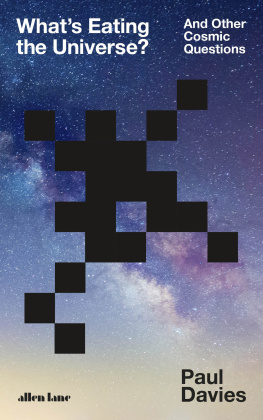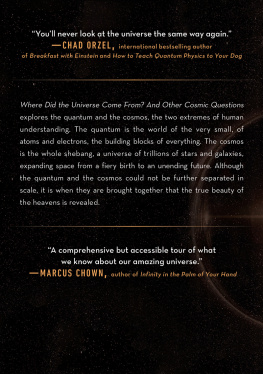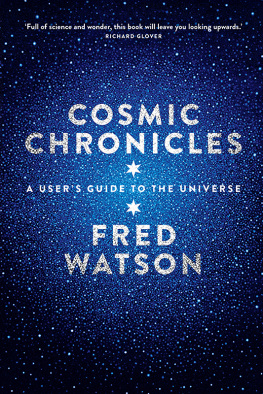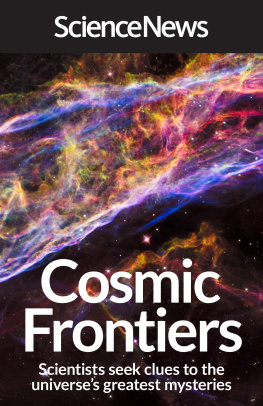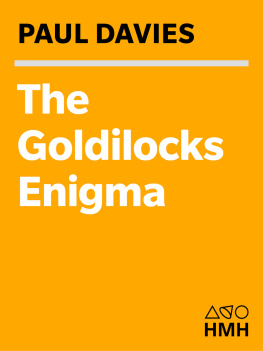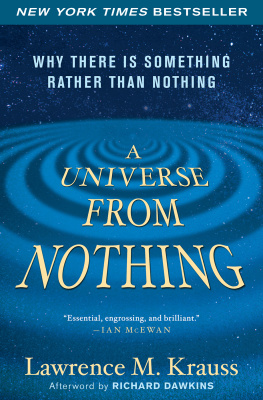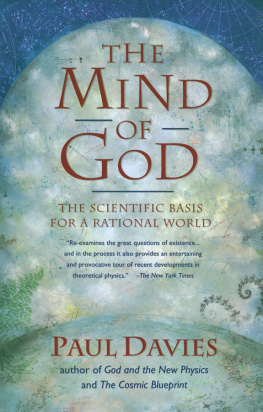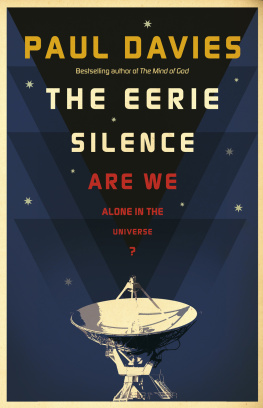P. C. W. Davies - Whats eating the universe? : and other cosmic questions
Here you can read online P. C. W. Davies - Whats eating the universe? : and other cosmic questions full text of the book (entire story) in english for free. Download pdf and epub, get meaning, cover and reviews about this ebook. year: 2021, genre: Children. Description of the work, (preface) as well as reviews are available. Best literature library LitArk.com created for fans of good reading and offers a wide selection of genres:
Romance novel
Science fiction
Adventure
Detective
Science
History
Home and family
Prose
Art
Politics
Computer
Non-fiction
Religion
Business
Children
Humor
Choose a favorite category and find really read worthwhile books. Enjoy immersion in the world of imagination, feel the emotions of the characters or learn something new for yourself, make an fascinating discovery.

- Book:Whats eating the universe? : and other cosmic questions
- Author:
- Genre:
- Year:2021
- Rating:3 / 5
- Favourites:Add to favourites
- Your mark:
- 60
- 1
- 2
- 3
- 4
- 5
Whats eating the universe? : and other cosmic questions: summary, description and annotation
We offer to read an annotation, description, summary or preface (depends on what the author of the book "Whats eating the universe? : and other cosmic questions" wrote himself). If you haven't found the necessary information about the book — write in the comments, we will try to find it.
Whats eating the universe? : and other cosmic questions — read online for free the complete book (whole text) full work
Below is the text of the book, divided by pages. System saving the place of the last page read, allows you to conveniently read the book "Whats eating the universe? : and other cosmic questions" online for free, without having to search again every time where you left off. Put a bookmark, and you can go to the page where you finished reading at any time.
Font size:
Interval:
Bookmark:

WHATS EATING the UNIVERSE?
and Other Cosmic Questions
PAUL DAVIES
The University of Chicago Press
The University of Chicago Press, Chicago 60637
2021 by Paul Davies
The author has asserted his moral rights.
All rights reserved. No part of this book may be used or reproduced in any manner whatsoever without written permission, except in the case of brief quotations in critical articles and reviews. For more information, contact the University of Chicago Press, 1427 E. 60th St., Chicago, IL 60637.
Published 2021
Printed in the United States of America
30 29 28 27 26 25 24 23 22 21 1 2 3 4 5
ISBN-13: 978-0-226-81629-6 (cloth)
ISBN-13: 978-0-226-81632-6 (e-book)
DOI: https://doi.org/10.7208/chicago/9780226816326.001.0001
First published by Allen Lane, an imprint of Penguin Random House UK, 2021.
Cover image: Cosmic microwave background, as observed by the Planck spacecraft. ESA and the Planck Collaboration
Library of Congress Cataloging-in-Publication Data
Names: Davies, P. C. W., author.
Title: Whats eating the universe? : and other cosmic questions / Paul Davies.
Description: Chicago: The University of Chicago Press, 2021. | Includes index.
Identifiers: LCCN 2021004010 | ISBN 9780226816296 (cloth) | ISBN 9780226816326 (ebook)
Subjects: LCSH: CosmologyPopular works.
Classification: LCC QB982 .D383 2021 | DDC 523.1dc23
LC record available at https://lccn.loc.gov/2021004010
 This paper meets the requirements of ANSI/NISO Z39.48-1992 (Permanence of Paper).
This paper meets the requirements of ANSI/NISO Z39.48-1992 (Permanence of Paper).
Contents
Preface
Whats Eating the Universe? is a scientific detective story. It explains how age-old cosmic puzzles have recently been solved, while startling new discoveries are upending our understanding of physical reality. To fully grasp the big picture, we must take a journey from the very edge of time itself, through our own epoch, into the infinite future. This is cosmology, the study of the origin, evolution and fate of the entire universe. It weaves together the large and the small, the vastness of space with the innermost recesses of subatomic matter a human endeavour of breath taking audacity, tackling fields of inquiry that for millennia lay exclusively in the provinces of religion and philosophy.
There may be those who feel that, when the bright light of scientific inquiry is shone into the hidden workings of nature, it strips away the romance of the unknown. I have always believed, however, that the deeper we probe, the more beautiful and awe-inspiring the physical world appears. Nature demystified is nature revealed in all its glorious subtlety and elegance. It is good that we should know. In the chapters that follow, we will explore humankinds cosmological discoveries in detail, and examine the fundamental philosophical questions that flow from them questions such as why the universe exists at all, why it has the form it does, why the laws of nature are as they are, and how a system of mindless, purposeless particles brought forth conscious, thinking beings who can make some sort of sense of their world.
I have been preoccupied by these big questions of existence all my life, and I am privileged to have been able to work on some of them professionally in my career as a theoretical physicist, cosmologist and astrobiologist. While my own contributions have been modest, I have rubbed shoulders with some of the giants of physics and astronomy, women and men of sparkling intellect and insatiable curiosity, whose infectious zeal for understanding the world from the perspective of science has been a constant source of inspiration. I have lived through one of the most exciting times in the entire scientific enterprise, when many big questions were transformed from dreamy theorizing to hard-won discovery. As so often in science, one question was answered only to raise a dozen others. And so it is today. Much has been achieved but much remains shrouded in mystery. I conceived of this book as a concise summary of our current state of understanding.
So many people have helped me with my research over the years that they are too numerous to list here, but I should like to acknowledge Cecilia Lunardini and Rich Lebed of Arizona State University, who clarified some aspects of particle physics for me, Charley Lineweaver of the Australian National University for his assistance with the characteristics of cosmological horizons, Glenn Starkman for his inspirational lecture about the oddities in the cosmic microwave background radiation, and Simon Mitton for drawing my attention to some historical inaccuracies. Lucy Hawking and Christopher McKay provided valuable help with the figures. Special thanks must go to my wife, Pauline, for her encouragement and critical reading of the text. Her communication skills far exceed mine, and much of the credit for the end product must go to her editorial refinements. Finally, I should like to thank my editor at Penguin, Chloe Currens, for her suggestions, comments and guidance, delivered in an unfailingly cheerful tone.
Paul Davies
Phoenix, March 2021
1. Journey from the Edge of Time
On 14 January 1990, the worlds press featured a mottled red-and-blue image purporting to show nothing less than the birth of the universe. It was like looking at the face of God, proclaimed the projects lead scientist, George Smoot. In the words of Stephen Hawking, the picture represented one of the greatest scientific discoveries of the century, if not all time.
The subject of these superlatives was a colour-coded heat map of the sky produced by a satellite called COBE, for Cosmic Background Explorer. COBE had been tasked with surveying the fading afterglow of the Big Bang, a sea of microwaves that suffuses space and travels to us largely undisturbed from a time when the cosmos was a tiny fraction of its current age. The amorphous-looking splodges decorating the image indicated slightly hotter and cooler regions of the universe. Etched into this kaleidoscopic pattern were important clues about the birth pangs of the cosmos a split-second after its origin, at the very edge of time itself.

Figure 1. All-sky map of the Big Bang afterglow obtained by the satellite COBE.
COBE ushered in a golden age of cosmology. In the three decades since, the field has been transformed from a speculative backwater to a precision science. Paradoxically, we now understand the history of the universe in its overall outline better than we understand the history of our own planet. Yet, to borrow from Churchill, this is not the end of cosmology. It is not even the beginning of the end. But it is, perhaps, the end of the beginning.
Cosmology might seem like a rarefied discipline, but in many indirect ways it touches everyone. We all have a need to know why the world is as it is and how we came to exist. Throughout history, societies have sought to address this need by producing creation myths: accounts which werent explanations in the scientific sense but stories intended to place human beings in the context of a grander scheme. When cosmology emerged as a scholarly discipline among the ancient Greek philosophers two and a half millennia ago, it was given a name that derived from the same root as cosmetic, meaning beautiful, whole and complete; standing in opposition to chaos. The word implied that there was such a thing as a universe, a coherent and organized entity that can be understood by human reason. Further progress, however, had to await the scientific age two thousand years later, which unleashed a stream of dazzling discoveries. When in 1543 Copernicus declared the Earth goes around the sun, he shattered the anthropocentric model of the cosmos that had prevailed for centuries. To be sure, the immediate effect on daily life was minor; there were no riots, no wars, no economic disruptions. Yet, over time, the knowledge that we are not located at the centre of the universe fundamentally transformed the context of all human existence. The impact was felt not only in science, but in religion, sociology and economics too.
Font size:
Interval:
Bookmark:
Similar books «Whats eating the universe? : and other cosmic questions»
Look at similar books to Whats eating the universe? : and other cosmic questions. We have selected literature similar in name and meaning in the hope of providing readers with more options to find new, interesting, not yet read works.
Discussion, reviews of the book Whats eating the universe? : and other cosmic questions and just readers' own opinions. Leave your comments, write what you think about the work, its meaning or the main characters. Specify what exactly you liked and what you didn't like, and why you think so.

